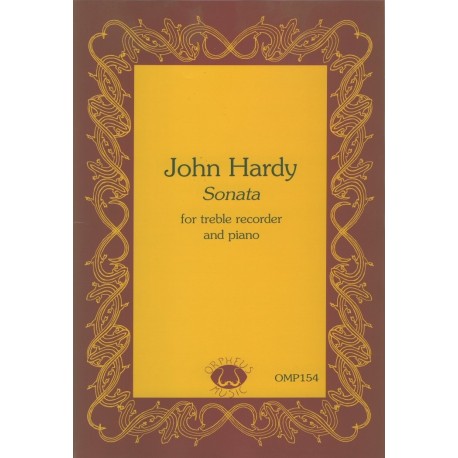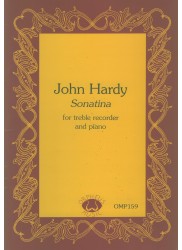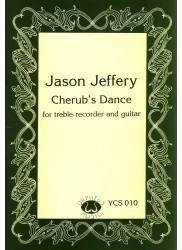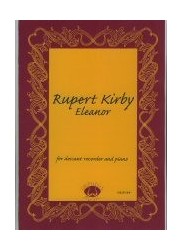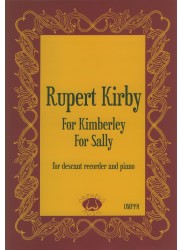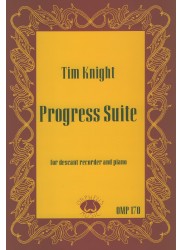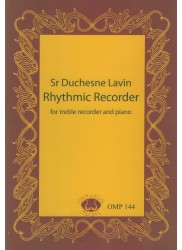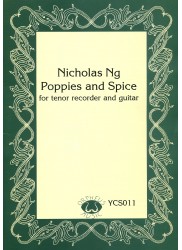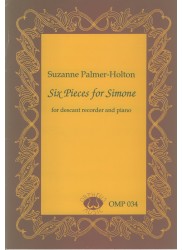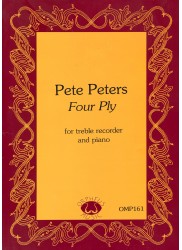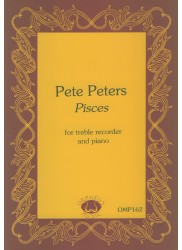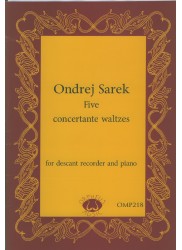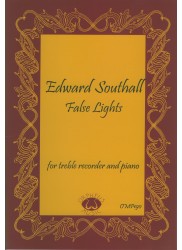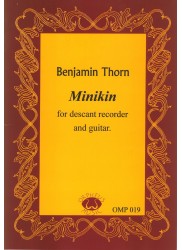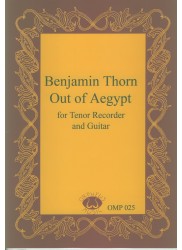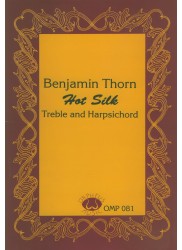No products
Prices are tax included
Sonata
OMP154.pdf
PLEASE NOTE - DOWNLOADABLE PDF VERSION
Composer: Hardy - John
Instrumentation: Treble + Piano
Period/genre: Contemporary
Grade: Very Difficult
More info
*Contemporary Piece.* Engaging and varied whole-tone piece.
1. Allegro moderato
2. Adagio
3. Allegro Grazioso/Trio quasi Landler/Allegro giocoso
4. Allegro con moto
Please note that due to the automated delivery of virtual products including pdf downloads, PayPal payment is required at the checkout - we are unable to accept the cheque payment method for these items.
_Score 20 pp. Part 12 pp. Downloadable PDF file._
OMP153 John Hardy Sonatina
OMP154 John Hardy Sonata
In these two pieces, Australian composer John Hardy (b. 1963) has restricted himself to the whole-tone scale for both melodic and harmonic material - and, in so doing, has perhaps risked setting the listener adrift in a musical sphere void of the harmonic tensions and landmarks to which tonal music has accustomed us. His idiom might be considered a form of scalar and harmonic minimalism.
In remarks accompanying the Sonatina, the composer in fact states that this soundscape is evocative of the Australian desert, "which...seems stark and inhospitable at first, but soon reveals its own special set of mysteries..." In his Twentieth-Century Harmony (1960), Vincent Persichetti cautions that "The true value of the whole-tone scale lies in the contrast it provides when it is used in combination with other scales and techniques."
The two versions of the wholetone scale are c-d-e-f#-g#-a#-c, and c#-d#-f-g-a-b-c#. Because the scales are symmetrical, the listener has no sense of tonic, and, without recurring rhythms, metric shifts and well-defined form, is liable to feel disoriented and ultimately bored. Hardy opposes the two scales from movement to movement, but never within a movement. With respect to holding our attention, he goes out on a limb, to some degree.
Hardy relies heavily on motivic economy, contrast, and formal re-iteration. Motivic interplay between the instruments abounds. Driving syncopations and off-beat accompaniment patterns engage the listener viscerally in the quick movements. Hardy avoids chordal accompaniment; chords derived from the whole-tone scale are inherently augmented in structure.
Without contrast to chords of other quality, tedium can take hold. The preponderant texture of the piano is two-part, and where the texture thickens, the recorder is well up in the range where it can hold its own. The composer could have offered more contrast in texture by thickening in passages where the recorder is tacit.
The publisher's web site rates both works as moderately challenging - way off the mark with respect to the Sonata, which is very demanding of soloist and accompanist alike. Highly disjunct melodic writing is the chief complication. Both the Sonata and Sonatina exceed the conventional recorder compass, and a number of slurred notes are unfeasible. Alternative fingerings are frequently warranted in brisk passages.
By convention, an accidental is not given next to a note that has been so inflected previously in a given bar. However, this practice does not lend itself to non-diatonic music. For ease of assimilation, the publisher could have applied accidentals throughout.
Orpheus Music has a catalog of over 200 pieces, the Majority of which are contemporary. Both of the works under discussion are available in PDF format from the publisher's web site.
From the pianist's point of view, an unbound format is more practical, since it eliminates difficult page turns. The score's narrow margins, and a staff width of only six millimeters, produces an overall cramped appearance.
By contrast, the recorder parts are easily-read, and page turns can be effected at leisure. The hard copy is simply staple-bound and will likely fall apart quickly.
At the time of writing, the Sonatina is incorrectly listed as "Sonata" on the web site. The composer's biography, as well as program notes supporting the exclusive use of the wholetone scale, appear at the end of the Sonatina score, but not in the Sonata.
These pieces are not liable to win over players or audiences immediately. This is true particularly of the four movement Sonata; at over 15' in duration, it could produce a severe wholetone allergic reaction. The Sonatina comes to about half the Sonata's duration. At roughly 2', the Sonatina's slow movement is terse, yet appealingly lyrical. Its merits might have been set in greater relief, had the surrounding movements not also been whole-tone.
Once technical obstacles are surmounted, these pieces may begin to ingratiate themselves to players. Audiences may require a few hearings before the music begins to deliver.
Those who find appeal in these pieces may also enjoy Claude Debussy's "Voiles" in his First Book of Preludes (~4') which, although predominantly whole-tone, does contain traces of pentatonicism and chromaticism.
Anthony St. Pierre, of Toronto, ON, American Recorder, January 2012
30 other products in the same category:
Reference: OMP153
Brand: Orpheus Music
Sonatina
Composer: Hardy - John Instrumentation: Descant + Piano Period/genre:...
In StockReference: OMP154
Brand: Orpheus Music
Sonata
Composer: Hardy - John Instrumentation: Treble + Piano Period/genre:...
In StockReference: OMP159
Brand: Orpheus Music
Sonatina
Composer: Hardy - John Instrumentation: Treble + Piano Period/genre:...
In StockReference: OMP159.pdf
Brand: Orpheus Music
Sonatina
PLEASE NOTE - DOWNLOADABLE PDF VERSION Composer: Hardy - John...
$19.00 -20%In StockReference: YCS010
Brand: Orpheus Music
Cherub's Dance
Composer: Jeffery - Jason Instrumentation: Treble + Guitar Period/genre:...
In StockReference: YCS010.pdf
Brand: Orpheus Music
Cherub's Dance
PLEASE NOTE - DOWNLOADABLE PDF VERSION Composer: Jeffery - Jason...
$16.00 -20%In StockReference: OMP184
Brand: Orpheus Music
Eleanor
Composer: Kirby - Rupert Instrumentation: Descant + Piano Period/genre:...
In StockReference: OMP184.pdf
Brand: Orpheus Music
Eleanor
PLEASE NOTE - DOWNLOADABLE PDF VERSION Composer: Kirby - Rupert...
$14.50 -20%In StockReference: OMP191
Brand: Orpheus Music
For Kimberley and For Sally
Composer: Kirby - Rupert Instrumentation: Descant + Piano Period/genre:...
In StockReference: OMP191.pdf
Brand: Orpheus Music
For Kimberley and For Sally
PLEASE NOTE - DOWNLOADABLE PDF VERSION Composer: Kirby - Rupert...
$16.00 -20%In StockReference: OMP170
Brand: Orpheus Music
Progress Suite
Composer: Knight - Tim Instrumentation: Descant + Piano Period/genre:...
In StockReference: OMP170.pdf
Brand: Orpheus Music
Progress Suite
PLEASE NOTE - DOWNLOADABLE PDF VERSION Composer: Knight - Tim...
$16.00 -20%In StockReference: OMP144.pdf
Brand: Orpheus Music
Rhythmic Recorder
PLEASE NOTE - DOWNLOADABLE PDF VERSION Composer: Lavin - Sr Duchesne...
$17.50 -20%In StockReference: YCS011
Brand: Orpheus Music
Poppies and Spice
Composer: Ng - Nicholas Instrumentation: Tenor + Guitar Period/genre:...
In StockReference: OMP034
Brand: Orpheus Music
Six Pieces for Simone
Composer: Palmer-Holton - Suzanne Instrumentation: Descant + Piano...
In StockReference: OMP149
Brand: Orpheus Music
Rolling in the Mud
Composer: Palmer-Holton - Suzanne Instrumentation: Descant + Piano...
In StockReference: OMP034.pdf
Brand: Orpheus Music
Six Pieces for Simone
PLEASE NOTE - DOWNLOADABLE PDF VERSION Composer: Palmer-Holton - Suzanne...
$14.50 -20%In StockReference: OMP160
Brand: Orpheus Music
Gobbledegook and other tunes for kids
Composer: Peters - Pete Instrumentation: Descant + Piano Period/genre:...
In StockReference: OMP161
Brand: Orpheus Music
Four Ply
Composer: Peters - Pete Instrumentation: Treble + Piano Period/genre:...
In StockReference: OMP162
Brand: Orpheus Music
Pisces
Composer: Peters - Pete Instrumentation: Treble + Piano Period/genre:...
In StockReference: OMP218
Brand: Orpheus Music
Five Concertante Waltzes
Composer: Sarek - Ondrej Instrumentation: Descant + Piano Period/genre:...
In StockReference: OMP218.pdf
Brand: Orpheus Music
Five Concertante Waltzes
PLEASE NOTE - DOWNLOADABLE PDF VERSION Composer: Sarek - Ondrej...
$20.50 -20%In StockReference: OMP190
Brand: Orpheus Music
False Lights
Composer: Southall - Edward Instrumentation: Treble + Piano Period/genre:...
In StockReference: OMP190.pdf
Brand: Orpheus Music
False Lights
PLEASE NOTE - DOWNLOADABLE PDF VERSION Composer: Southall - Edward...
$16.00 -20%In StockReference: OMP019
Brand: Orpheus Music
Minikin
Composer: Thorn - Benjamin Instrumentation: Descant + Guitar Period/genre:...
In StockReference: OMP019.pdf
Brand: Orpheus Music
Minikin
PLEASE NOTE - DOWNLOADABLE PDF VERSION Composer: Thorn - Benjamin...
$14.50 -20%In StockReference: OMP025
Brand: Orpheus Music
Out of Aegypt
Composer: Thorn - Benjamin Instrumentation: Treble/Tenor + Guitar...
In StockReference: OMP025.pdf
Brand: Orpheus Music
Out of Aegypt
PLEASE NOTE - DOWNLOADABLE PDF VERSION Composer: Thorn - Benjamin...
$16.00 -20%In StockReference: OMP081
Brand: Orpheus Music
Hot Silk
Composer: Thorn - Benjamin Instrumentation: Treble + Harpsichord...
In StockReference: OMP081.pdf
Brand: Orpheus Music
Hot Silk
PLEASE NOTE - DOWNLOADABLE PDF VERSION Composer: Thorn - Benjamin...
$17.50 -20%In Stock

